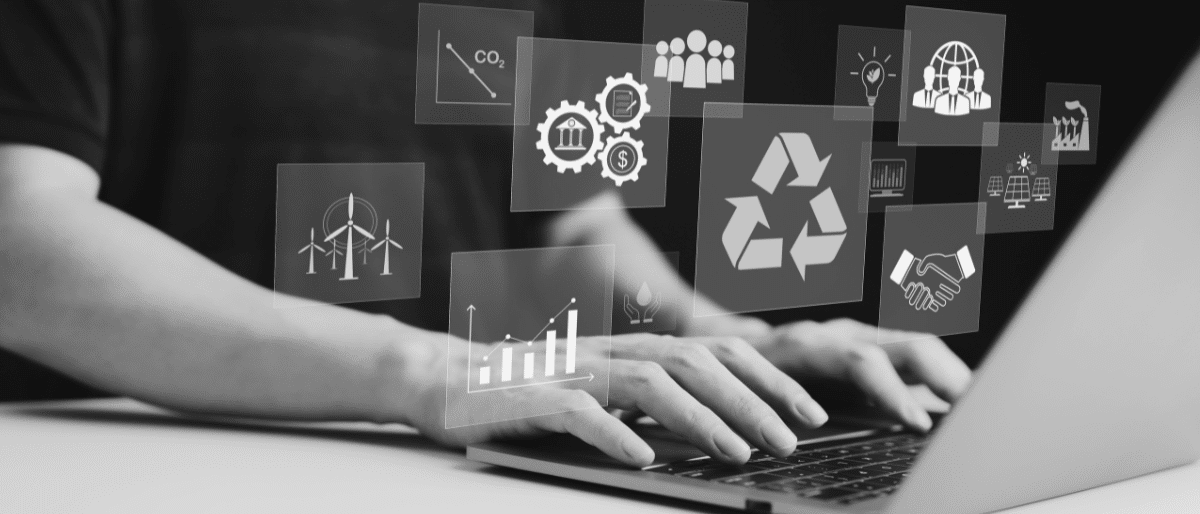Software and technology are an increasingly vital part of society, transforming countless industries and connecting people worldwide. But behind every innovation, there is often an overlooked environmental cost. The UN Environment Programme estimates that the information and technology sector contributes nearly 4% of global greenhouse gas emissions, a figure on par with the aviation industry.
With digital transformation continuing to accelerate, artificial intelligence becoming more popular, and consumer awareness of climate issues growing, the technology industry finds itself at a pivotal moment. Beyond being a cause of environmental challenges, technology has the potential to become part of the solution, empowering society to address these issues while also minimising its own environmental footprint.
After becoming the first major economy to legislate to reach net zero by 2050, the UK is committed to using technology to address climate challenges – and so are we at Equal Experts. Alongside our commitment to achieving net-zero carbon emissions by 2030, we’re proud to have recently become a member of the UK Government Digital Sustainability Alliance (GDSA).
Driving sustainability with the GDSA
The GDSA brings together the UK government, its Information and Communications Technology (ICT) and digital supply chain, academics and third sector organisations to drive progress on the sustainability of the UK government’s ICT and digital estate.
Formed in 2022 by Chris Howes, Defra’s Chief Digital and Information Officer and the UK government’s Senior Responsible Owner for Sustainable ICT, the alliance works to:
- Identify key risks and opportunities in the procurement and operation of the government’s ICT estate, which support sustainable digital practices
- Develop and promote best practice, solutions, tools and guidance for tackling strategic challenges
- Support the work of the UK government in this area by providing expertise and feedback when required to support policy and strategy development.
Our membership reflects our commitment to working collaboratively with our partners, including UK government organisations, to solve problems, deliver practical, sustainable technology solutions and upskill teams with environmentally-friendly software development skills.
Building sustainability into digital delivery
Our commitment to sustainability goes beyond our net-zero pledge and GDSA membership – it’s something we put into practice across our client work.
Digital technology’s environmental footprint is real and growing. Organisations are increasingly turning to their CTOs to address it, with 81% of senior IT leaders saying in a recent survey that “green IT,” or “reducing their tech-related environmental impact,” was one of their top priorities.
From the energy used by cloud data centres to how we write software or design services, every choice can either make environmental issues worse or be a source of positive change. By embedding sustainability by design within digital delivery, we can ensure technological advancements prioritise low emissions and sustainable practices from the outset.
Key elements of sustainable digital delivery include:
- Sustainable cloud strategy
Moving from inefficient on-premises servers to cloud services can lower emissions, but only if organisations design and implement a sustainable cloud strategy. Efficient resource consumption, through right-sizing instances, autoscaling and optimising storage and networking, not only reduces cloud overspend but can also help minimise energy consumption and waste.
- Optimise software efficiency
The way software is built and run has a major impact on energy use. Inefficient code can lead to higher CPU usage, increasing electricity consumption and emissions. Clear, well-structured code can minimise resource usage and computational overhead.
- Embrace agile and lean development
Agile and lean methods help reduce waste by delivering software that directly meets users’ needs and expectations, avoiding over-engineering, rework and technical debt, while also optimising software performance and quality.
- Collect, store and present data efficiently
Data storage and processing consume significant energy. Minimising data footprints, for example by regularly deleting unnecessary data, can help reduce costs and emissions. Organisations should also focus on efficiencies in data collection, only collecting data that is absolutely necessary.
- Choose lightweight, accessible design
The design of apps and websites also plays a role in sustainability. Complex websites with large images, videos, or scripts increase data transfer, raising energy use on both servers and devices. Globally, the average web page produces approximately 0.8 grams of CO2 equivalent per pageview, according to the website carbon calculator. By designing leaner, faster pages, organisations can lower their environmental impact and speed up user experiences. Accessible design also reduces waste by creating a single well-built service that works for everyone, reducing the need for multiple systems.
- Optimise hardware lifecycle management
The environmental cost of manufacturing, transporting, and disposing of IT hardware is often overlooked. Encouraging a circular economy where products and materials are kept in circulation, for example by reusing or refurbishing laptops and servers, implementing responsible e-waste recycling, and choosing suppliers with sustainable manufacturing practices, can reduce e-waste.
- Build a culture of sustainability
Small day-to-day habits can add up across a large organisation. Encouraging staff to avoid unnecessary printing, power down equipment when not in use, or limit large email attachments can help significantly reduce energy use when adopted at scale.
Adopting tools and processes to measure the carbon footprint and track progress toward targets can help drive accountability and continuous improvement.
Partnering for progress
We believe that technology can be a driving force for a sustainable future. Alongside our commitment to achieving net zero emissions, we continue to collaborate with cloud technology providers Amazon, Google and Microsoft to help our large-scale customers optimise cloud usage to reduce energy consumption.
As members of the GDSA, we’re committed to collaborating across government, industry, and academia to advance greener digital practices. This includes providing user research and service design expertise to support the public sector in testing a set of principles for the design and delivery of greener services, with the aim of wider adoption across Defra and the government.
Within our client engagements, we embed energy-efficient coding practices and help optimise cloud computing. For example, we helped a leading European insurance provider optimise its cloud architecture, reducing cloud spend by 23% while ensuring no interruption to its systems and services. Read the full case study.
Similarly, we worked with IG Group to upskill its software development team and reduce rework, resulting in the change failure rate declining from 33% to zero. This helped remove barriers to cloud adoption and establish a foundation for future agility, cost-efficiencies and sustainable development practices. Read the full case study.
Our client work and core values show we don’t believe in a silver bullet to transform sustainability. But we are a thoughtful, experienced partner dedicated to long-term, meaningful change.
Learn more about the Government Digital Sustainability Alliance and how you can get involved on the GDSA website. Or contact our team to start embedding sustainability in your organisation’s digital delivery.




